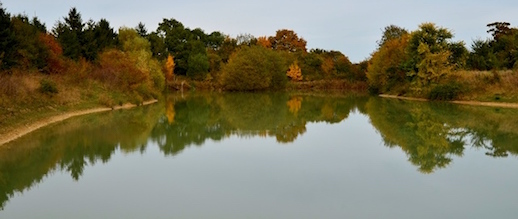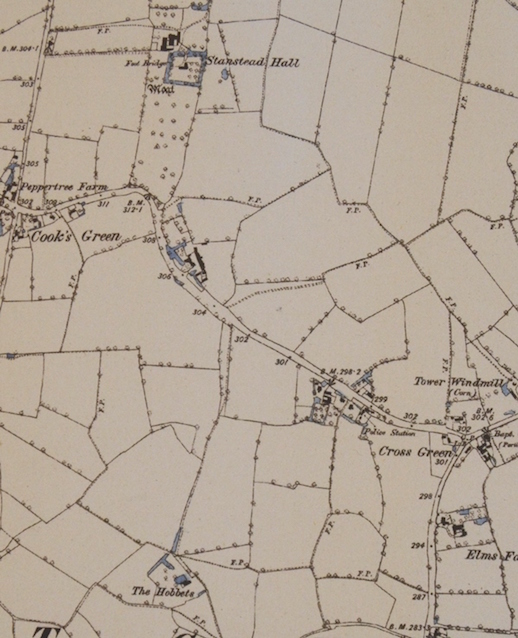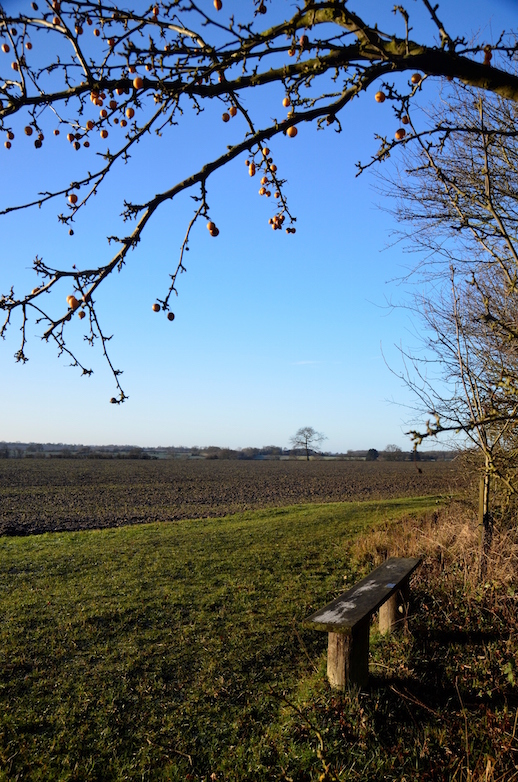Yalda Davis explores the history of the reservoir she has known all her life, as well as the transformative effects of swimming in it

Today the first leaves and twigs are on the water, from the wind in the night. I’m used to swimming with only the odd feather floating on the surface, and the occasional nibble from a small fish when I wade in. The carp, some up to a foot long, are swimming fast just under the surface, creating V-shaped ripples behind them: even though they are small, my mind immediately leaps to sharks. I sit and watch them for a while, wondering why they are in such a great hurry, changing direction, some this way, some that, with no pattern that I can determine.
I have known the reservoir all my life – we used to come here on walks and to collect fossils throughout my childhood – but for some reason it only occurred to me a few years ago that I would try swimming in it, reasoning that if it was good enough for the fish, it was good enough for me. That same summer I saw two young boys doing the same, and a number of people fishing on several occasions: the place I thought of as secret had, to my disappointment, become a popular destination. Since then, though, it has mostly gone back to its old ways, and when I am there alone I can continue my fantasy that no one else knows it exists. No one but the birds, fish and the occasional dog, usually arriving alone with its owner following some way behind. Sometimes the owner never appears at all.
I have never been a cold water person. Until a week ago, it was only on the hottest days of the year that I would venture in, and even then I would have to wade in very slowly to gradually match my skin temperature to the water. The water is not even that cold – the reservoir is quite shallow, with a clay bottom, and warms up quickly in the sun. I still need the relative warmth of summer, but in the last week I have swum when it was cloudy, in the rain, without wading in slowly, and with my head under water, all for the first time.
Swimming in the rain was a revelation; it is probably one of the best ways to appreciate the wonder of rain falling. I brought my eyes as close to water level as I could, watching and listening as the droplets bounced and fizzed into a mist a few inches high. I imagined being able to take a photograph at this level: if the shutter speed was fast enough, there would be thousands of tiny columns of water reaching up into the air, like a miniature forest of water sculptures. I’m sure plenty of photographers have captured this moment but I have not yet managed to find a representation of the image I have in my mind. Most photographs of raindrops hitting water are taken from above water level, to show the thousands of overlapping circles created by the splashing droplets – another of nature’s geometrical works of art.
Submersing myself fully was also a transformative experience. I arrived home on a humid day feeling sick and drained after running errands, and for once I knew the remedy: total immersion in water. But not just any water. I immediately headed for the reservoir, and emerged after only a few minutes completely recovered and clear-headed, as though the water had passed right through me like rinsed-out washing. After that I no longer need the enticement of muggy weather to repeat the experience.
I notice when I take my dry swimming costume off the washing line that, instead of the usual chlorine, it still smells of the water from the reservoir. Other languages describe it better than we do: sweet water, not fresh water. When I am swimming with my nose an inch or two above the surface, I breathe in deeply to savour that smell. People are usually surprised when I say I swim here, and ask if it is safe – it is an agricultural reservoir, with cloudy water, and surrounded by intensively farmed arable fields. I’m sure it is not the freshest water in the world, but its smell must say something for it, and I always persuade myself that clay has a purifying effect; after all, macaws in the rainforest eat clay to neutralise the toxins in their diet. Not to mention that the swallows drink it.
*
The first time I saw swallows come down to drink, I didn’t quite believe they were swallows. Partly because I couldn’t see their distinctive colouring, nor many streamers – I think many were juveniles – but mainly because so few swallows visit my garden, just a field away, that I couldn’t imagine such a quantity of them congregating so close by.
It seemed like a dream; I was mesmerised. I thought they must be catching insects above the surface of the water, until I saw them slow down just enough to scoop up water in their beaks before rising up again, turning back and repeating the process, with graceful acrobatics in between. I went back many times in the following weeks, hoping to witness the spectacle again, which I did on a few occasions, but there were never as many swallows as that first time. I wonder if September is the best time for it, just as they are gathering to start their migration. I will put my theory to the test this year.
When a swallow or two appears when I am swimming, I feel deeply honoured that they are not disturbed by my presence. Watching them from water level is an even more magical experience.
*
I thought the reservoir had been there all my life, but discovered recently that it does not appear on the 1980 ordnance survey map, so it must have been dug shortly after. This was confirmed by one of the owners of the land – living at Dale Farm, directly to the west of The Hobbets – whom I met by chance one day while out on a walk, although she didn’t know the exact year it was constructed.
 1884 Ordnance Survey map showing Cook’s Green (upper left), Stanstead Hall (top centre), Cross Green (lower right) and The Hobbets (bottom centre)
1884 Ordnance Survey map showing Cook’s Green (upper left), Stanstead Hall (top centre), Cross Green (lower right) and The Hobbets (bottom centre)
It is a magical place even in the swallows’ absence. Even its name, The Hobbets, evokes fantasy. I have not been able to find out the origin of the name, but a local archaeologist and historian, Edward Martin, sent me what he knew about it: ‘A mystery holding that was possibly a part of the manor of Stanstead Hall [at Cook’s Green]. In 1595 John Cooke had a ‘tenement and ground called Hobbys’, and in 1733 there is mention of Hobbes Lane. Hobbetts Ley and Hobbetts Meadow occur in 1840, and it was called The Hobbets in 1884′¹.
I found a more detailed description on the ‘The Suffolk Heritage Explorer’ website, also written by Edward Martin: ‘The Hobbets: remains of small moated enclosures. The Tithe Map of 1839 shows a small irregular moated enclosure containing a house, this had an entrance causeway on the E side; to the N of this were the remains (principally the N & E sides) of a slightly larger moated enclosure, then used as an orchard. To the E of these was a barn and several ponds. Most of the site has now disappeared under a recently constructed large pond with embanked sides. Parts of the eastern and southern sides of the site still survive under scrub vegetation and trees. Referred to as Hobbyes tenement in the C17. It does not appear to have been a copyhold tenement of the manor of Hitcham and may have been freehold’².
On a quest to find out more about The Hobbets, I eventually also discovered a short book by Leonard Bull, available second hand from only one online book seller, called Remembering Hobbets. With no description of the book given, I wasn’t sure at first if it was even about the right place – although, finding no reference on the internet to any other Hobbets anywhere in the world except as a spelling variant (or mistake) of ‘hobbits’, it seemed highly unlikely that it could refer to anywhere else. Another clue was in the author’s name, as the Bull family is long established in Hitcham, and further investigation revealed that Leonard Bull (1902-1996) indeed belonged to this family. He lived all but the last 4 years of his life at Brickhouse Farm, near Hitcham church, and his father owned The Hobbets when he was a child.
My first pleasing discovery in the book was that a sense of adventure has been part of The Hobbets for a long time: as a child in the years before the First World War, Leonard Bull and his friends used to explore the largest of the various ponds at The Hobbets, in a cattle trough boat with a shovel for a paddle. I am sure they were not the first children to go on such explorations.
 Winter view from The Hobbets
Winter view from The Hobbets
My delight in this image was subdued, however, by a poem Bull wrote in 1992 from which the book takes its name, which laments the fate of The Hobbets: the destruction of its meadows, the barn’s demise, and the loss of a lovers’ meeting place and children’s games. Lost in his sorrow – which I can well imagine and share a small part of, although I never knew the place as it was before – he seemed not to realise that, although ‘future children will not know/ The pleasure that was ours’, its revised existence still has enchantment. When he wrote these words, it was already providing me with a child’s pleasure, and it continues now to give me new pleasures and new adventures – ones that perhaps should have begun in childhood, had the freedom to roam unsupervised remained part of a child’s existence by the end of the century.
Aside from this poem, there is disappointingly little in the book actually about The Hobbets. There is a physical description of it and a digitised map of the area which has been so simplified and rectangularised as to be almost useless in trying to imagine the layout of the meadows and farm buildings. Bull writes that there was a family living in a house there until at least the mid 19th century, and that the barn, probably built in the 15th century, fell down in the 1980s. There is not much left to see of the barn apart from some oddly constructed brick foundations – bricks laid narrowest side down, apparently unheard of as a building technique – and nearby is some abandoned pre-combine farm equipment. I have now been told where the house was located, but the bricks had been sold off and I could find no remains.
¹ Martin, E., by email, September 2015
² Suffolk Heritage Explorer. HTC 026 – The Hobbets (site of) https://heritage.suffolk.gov.uk/hbsmr-web/record.aspx?UID=MSF10948-The-Hobbets-%28site-of%29&pageid=16&mid=9. Source: Martin, E., 1990.
Keep an eye out for The Hobbets: Part 2, to be published in the coming weeks. Read more from Yalda on her blog.